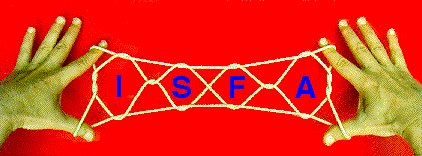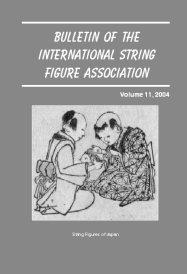Volume 11 (2004): 288 pages - Table des Matières
Edité par - Mark A. Sherman, Pasadena, California
Rédacteurs Associés - Joseph D'Antoni, Queens, New York; Myriam Namolaru, Haifa, Israel;
Belinda Holbrook, Davenport, Iowa; Stephan Claassen, Best, Netherlands.
Comité de Rédaction - Hiroshi Noguchi, Tokyo, Japan; Philip Noble, Inverness, Ecosse
Le Bulletin de l'Association Internationale du Jeu de Ficelle (BISFA) est une publication savante
présentant des documents originaux qui fait progresser notre compréhension et renforce
notre plaisir des jeux de ficelle. BISFA est publié annuellement, en septembre, par ISFA Press
(Pasadena, Californie). BISFA remplace le Bulletin de l'Association des Jeux de Ficelle,
(Toky Nippon Ayatori Kyokai), qui a été publiée en 19 volumes (1978-1993).
Les traductions proposées ne comprennent pas les illustrations et photos du texte original.
J'ai traduit ces textes pour vous donner un aperçu de la qualité et de la richesse de
ces publications.
Special Issue
- Ayatori: The Traditional String Figures of Japan, by Tama Saito, Saitama, Japan, prepared for publication by Yukio Shishido, Kyoto, Japan, (pages 1-286) - The Japanese have enjoyed playing string games for at least 340 years and probably much longer. During a series of field trips between 1970-1980, and at every opportunity that arose between 1981-1999, author Tama Saito traveled throughout Japan learning traditional string figures and tricks from anyone who was kind enough to teach her. After 30 years of tedious work her collection includes an astounding 274 methods, which she has chosen to publish here in English translation. For each figure or trick, the author provides the reader with informative cultural notes, an exhaustive list of titles, the location at which it was learned, the sex and age of the informant, and one or more artistic sketch made with brush, pen, and ink. Of special note is the author’s comprehensive survey of the Japanese cat’s cradle series, both the two-player version and the solo version. Four introductory chapters summarize the circumstances that allowed her to travel, her collecting experiences, the generic names her informants used in referring to string figures, and the rules they observed when playing cat’s cradle. Appendix 1 presents 24 Japanese-style figures and methods invented by the author. Appendix 2 provides readers with maps of Japan showing the 47 prefectures mentioned in the text. (j'ai traduit seulement le texte du début et quelques figures)
Ajouter un commentaire






